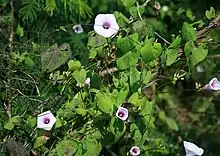Ipomoea trifida
Ipomoea trifida is a species of Ipomoea morning glory also known as the threefork morning glory. It is native to the Caribbean, Mexico, and South America.[2] I. trifida is known for being the closest living wild relative to I. batatas, or the common sweet potato, and is believed to have split from this relative at least 800,000 years ago.[3][4] The roots of this plant are thin and inedible, while the flowers tend to be purple.
| Ipomoea trifida | |
|---|---|
 | |
| Scientific classification | |
| Kingdom: | Plantae |
| Clade: | Tracheophytes |
| Clade: | Angiosperms |
| Clade: | Eudicots |
| Clade: | Asterids |
| Order: | Solanales |
| Family: | Convolvulaceae |
| Genus: | Ipomoea |
| Species: | I. trifida |
| Binomial name | |
| Ipomoea trifida | |
| Synonyms | |
References
- "Ipomoea trifida". 2014 Annual Checklist. Catalogue of Life. Retrieved 2019-07-11.
- "ITIS Standard Report Page: Ipomoea trifida". www.itis.gov. U.S. Fish and Wildlife Service. Retrieved 2019-07-10.
- Zimmer, Carl (2018-04-12). "All by Itself, the Humble Sweet Potato Colonized the World". The New York Times. Retrieved 2019-07-10.
- Fox, Alex (2018-04-12). "Sweet potato migrated to Polynesia thousands of years before people did". Nature. doi:10.1038/d41586-018-04488-4. Retrieved 2019-07-11.
External links
 Media related to Ipomoea trifida at Wikimedia Commons
Media related to Ipomoea trifida at Wikimedia Commons Data related to Ipomoea trifida at Wikispecies
Data related to Ipomoea trifida at Wikispecies- Discover Life
This article is issued from Wikipedia. The text is licensed under Creative Commons - Attribution - Sharealike. Additional terms may apply for the media files.